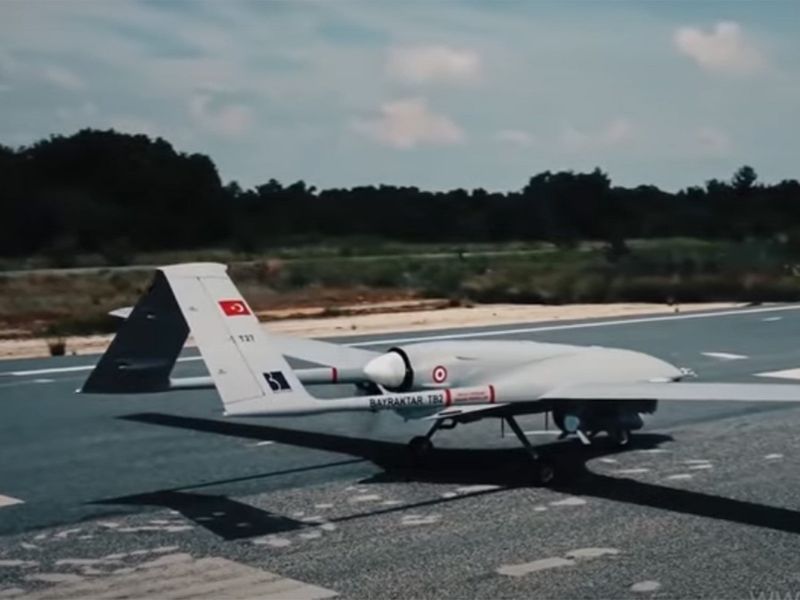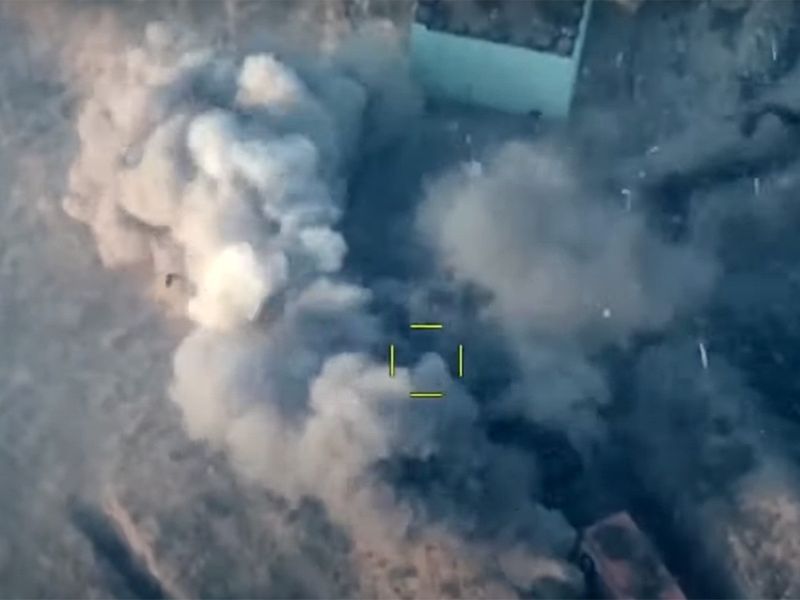Moscow: The drone’s-eye-view over Nagorno-Karabakh defined much of the six-week war in the mountainous enclave within Azerbaijan: The video first showed soldiers below in trenches, then came blasts and smoke, then nothing.
Drone strikes – targeting Armenian and Karabakh soldiers and destroying tanks, artillery and air defence systems – provided a huge advantage for Azerbaijan in the 44-day war and offered the clearest evidence yet of how battlefields are being transformed by unmanned attack drones rolling off assembly lines around the world.
The expanding array of relatively low-cost drones can offer countries air power at a fraction the cost of maintaining a traditional air force and, as in Nagorno-Karabakh, underscored how drones can suddenly shift a long-standing conflict and leave ground forces highly exposed.
On November 10, Armenia accepted a cease-fire on punishing terms to possibly end the latest round of fighting over Nagorno-Karabakh, an enclave controlled by ethnic Armenian factions but inside the internationally recognised borders of Azerbaijan.
“Drones offer small countries very cheap access to tactical aviation and precision guided weapons, enabling them to destroy an opponent’s much costlier equipment such as tanks air defence systems,” said Michael Kofman, military analyst and director of Russian Studies at the Centre for Naval Analyses in Arlington, Virginia.
“An air force is a very expensive thing,” he added. “And they permit the utility of air power to smaller, much poorer nations.”

In Azerbaijan, the videos of the drone strikes have been posted daily on the website of the country’s Defence Ministry, broadcast on big screens in the Azerbaijan capital, Baku, and tweeted and retweeted online.
They were also studied by Western military analysts to track Azerbaijan’s swift military gains.
Thousands of protesters gathered in the Armenian capital, Yerevan, on Wednesday as pressure grew for Prime Minister Nikol Pashinyan to step down after agreeing to a deal that will see a 2,000-strong Russian peacekeeping mission and Azerbaijan regaining territory it lost in war in the early 1990s.
The deal came just after Azerbaijan took the strategic city of Shusha (known in Armenia as Shushi), a town of cultural importance to Azerbaijan perched high above the Nagorno-Karabakh capital, Stepanakert. As Azerbaijan forces advanced toward Shusha, its military propagandists published gruesome videos of drones destroying forces in trenches.
Armed drones have increasingly become part of warfare since the Pentagon deployed its Predator drone in Afghanistan following the September 11, 2001, attacks. Missile-firing drones are now produced in many countries including Turkey, China and Israel, and have been used by various sides in battles including Libya’s proxy war.
In a matter of months, however, Nagorno-Karabakh has become perhaps the most powerful example of how small and relatively inexpensive attack drones can change the dimensions of conflicts once dominated by ground battles and traditional air power.
It also highlighted the vulnerabilities of even sophisticated weapons systems, tanks, radars and surface-to-air missiles without specific drone defenses. And it has raised debate on whether the era of the traditional tank could be coming to an end.
Azerbaijan used its drone fleet – purchased from Israel and Turkey – to stalk and destroy Armenia’s weapons systems in Nagorno-Karabakh, shattering its defenses, enabling a swift advance. Armenia found that air defense systems in Nagorno-Karabakh, many of them older Soviet systems, were impossible to defend against drone attacks, and losses quickly piled up.
Franz-Stefan Gady, a research fellow on future conflict at the International Institute for Strategic Studies, said traditional military equipment such as tanks and armor vehicles will not become obsolete.
But Nagorno-Karabakh has shown “the ever-increasing importance” of using armed drones along with other weapons and highly trained ground forces and “the exponentially more devastating consequences of failing to do so in future wars,” he said.
The separatist region in Azerbaijan with a largely Armenian population broke away in the late 1980s leading to war and Azerbaijan’s humiliating loss of the enclave and seven surrounding districts. A decades-long process, led by the United States, France and Russia, failed to reach a settlement.
Armenia became content with the status quo of a frozen conflict, retaining territory. But Azerbaijan, frustrated at a peace process that it felt delivered nothing, used its Caspian Sea oil wealth to buy arms, including a fleet of Turkish Bayraktar TB2 drones and Israeli kamikaze drones (also called loitering munitions designed to hover in an area before diving on a target).
When fighting flared again on September 27, the drone videos playing on big screens in Baku and on YouTube stoked popular support for the war, even as Azerbaijan hid figures on its own war dead.
“It’s pretty obvious that Azerbaijan has been preparing for this. Azerbaijan decided it wanted to change the status quo and that the Armenian side had no interest in a war because they wanted to keep what they had,” said Tom De Waal, expert on the Caucasus at the Carnegie Endowment for International Peace.
“Clearly the decisive factor in this conflict is Turkey’s intervention on Azerbaijan’s side. They seem to be heavily coordinating the war effort,” he said adding that it appeared Turkey had moved Syrian mercenaries into Azerbaijan two weeks before the conflict.
Turkey denies recruiting Syrian mercenaries to fight in Nagorno-Karabakh.
And then there were the drones. Their targets included fortified positions from the 1990s.
“There were massive losses,” De Waal said. “Possibly around a third of Armenian tanks have been destroyed. That’s obviously been a critical factor in taking all those territories.”
Unable to match Azerbaijan’s drone power Armenian forces, demoralised and wracked by COVID-19 suffered military calamities.
Officials from Armenia and Nagorno-Karabakh said they had no choice by to sign Tuesday’s truce to avoid further losses of life and territory.

In the early stages of the war, Azerbaijan used 11 slow old Soviet-era An-2 aircraft that had been converted into drones and sent them buzzing over Nagorno-Karabakh as bait to Armenian air defence systems, tempting them to fire and reveal their positions, when they could be hit by drones.
It used surveillance drones to spot targets and sent armed drones or kamikaze drones to destroy them, analysts said.
Turkey, which took part in joint military exercises with Azerbaijan forces in Azerbaijan over the summer, supports its ally but denies direct involvement in the fighting.
But Azerbaijan likely benefited from Turkey’s experience of its recent use of drones in Syria as well as Libya.
Videos posted by both sides in Nagorno-Karabakh – including drone hits and soldiers advancing through villages and towns – enabled military analysts to tally confirmed hits.
Stijn Mitzer, an analyst writing in the military affairs blog Oryx, noted that both sides used propaganda to play up their military gains but analysis of video footage made it possible to verify the claims. The group published a list of the destroyed military hardware, including photographic or video evidence for each tanks and weapon system.
Their tally, which logs confirmed losses with photographs or videos, listed Armenia losses at 185 T-72 tanks, 90 armoured fighting vehicles, 182 artillery pieces, 73 multiple rocket launchers, 26 surface-to-air missile systems include a Tor system and five S-300s, 14 radars or jammers, one SU-25 war plane, four drones and 451 military vehicles.
Azerbaijan, the group concluded, had visually confirmed losses of 22 tanks, 41 armoured forced vehicles, one helicopter, 25 drones, and 24 vehicles. The full tally of losses on both sides cannot be independently verified, however Armenian losses appear significantly higher, according to military analysts.
The leader of Nagorno-Karabakh Arayik Harutyunyan said Tuesday that all of Nagorno-Karabakh would have been taken “within days” had fighting continued, citing the “very heavy human losses” inflicted by drones.
Malcolm Davis, a senior analyst at the Australian Strategic Policy Institute, wrote on the Real Clear Defence website that systems such as the kamikaze, or loitering, drones likely will become more prevalent as technology improves and costs go down.
“That’s a potential game-changer for land warfare,” he wrote.

